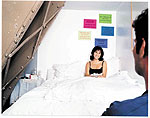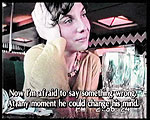Intimate Picasso | Sophie Calle | Techie toyz | Morrison's fans

 “Chambre avec vue, 2003,” Eiffel tower installation, Nuit Blanche, Oct 5, 2003
“Chambre avec vue, 2003,” Eiffel tower installation, Nuit Blanche, Oct 5, 2003
© ADAGP, 2003,PARIS/PHOTO - S. SENNE
|
Has anybody seen Sophie Calle?
by Tobias Grey

If you get a chance to visit the Sophie Calle exhibition at the Pompidou Center, do not be surprised if you feel like you are being followed... you just may well be.
Creepy as that sounds rest assured that it’s all in the name of art. More precisely it’s part of an installation (“A Woman Vanishes”) Calle was inspired to make after she read a magazine article about the disappearance of a young woman called Bénédicte Vincens. A security guard at the Pompidou Center before she went missing, Vincens it also turned out was a big fan of Calle’s work.
This news inspired Calle to pay tribute to Vincens in her own inimitable fashion. “I met some of her [Vincens’] colleagues at the Pompidou Center. They told me that she was interested in the behavior of visitors, and wanted to use her position as a guard to study them,” says Calle. “For the exhibition ‘M’as-tu vue’ I decided, in her name, to implement this plan.” Do not, though, expect Calle to be doing the stalking, she gave that up a long time ago. In fact the last time was in 1979 when she bumped into a handsome stranger at a Paris party and that same night decided to follow him to Venice. Once there, donning dark glasses and an overcoat she pursued her quarry over two weeks, photographing him unawares, until finally he unmasked her and let her know the game was up.
The result was “Suite Venitienne” a breathless account of her pursuit told in Calle’s trademark text and photographs. Conscious of overstepping the law Calle photographed her stranger so we cannot see his face to distinguish him. “I did it seriously with fear, with anxiety,” Calle says, “I established the rules of a game and I followed them, as I always do, to their conclusion.”
What makes Calle’s art so intriguing is that every project’s outcome always lies in the balance. Just how ready to be works of art are Calle’s real life protagonists? The man from “Suite Venitienne” may have reacted relatively coolly to Calle’s stalking him but not everybody has proved to be such a willing participant.
In 1983 the French daily Libération invited Calle to do an instalment piece for publication that summer. Soon afterwards Calle found an address book in the street the contents of which she photocopied. She then sent the book back anonymously to its owner, whose address was written on the endpaper. Calle decided to contact some of the people whose names appeared in the book and asked them to tell her about the owner.
Her investigations gave rise to 28 consecutive articles in Libération creating the portrait of a man she had never met through the eyes of his colleagues. Each article (which kept the subject’s identity anonymous) was accompanied by photographs depicting a detail of the man’s life: be it a favorite painting, or a particular brand of cigar.
For that summer Calle was a latter-day Dickens with people waiting on tenterhooks for the next day’s instalment. The only hitch was that when Calle’s chosen subject, a documentary maker called Pierre Baudry, returned from a long vacation he went public with how outraged he was. Getting even Baudry dug up a nude photo from Calle’s past and had it published in the same paper.
Today Calle has ambiguous feelings towards a work she christened “The Address Book” and of which she refuses any attempts to have displayed: “It’s the one work of mine I have a doubt about. It was not morally wrong but almost. I made this man suffer so I was cruel in a way. I didn’t think I was going to be because everybody I interviewed at the time said, ‘he’s going to love it, it’s for him, and he’s the most perfect person for this.’ So I was carried away by this absolute certainty that he was going to love it. When I found out that he received it badly and suffered I had regrets but I must admit I would do the same again.”
“M’As-Tu Vue” — meaning literally “Have You Seen Me?” or in colloquial French “Show-Off” — is how Calle has chosen to call her exhibition. Roughly three quarters of it is made up of new installations so there is no room for the likes of “Suite Venitienne” and her other notorious installation from the 1980s “Hotel” (a work for which she managed to get herself engaged as a temporary chambermaid in a Venice hotel so as to snoop through the personal belongings of its guests, copy down extracts from their diaries, take notes and photograph their possessions), nor “No Sex Last Night” (The video diary of a road trip Calle took across the United States with her then boyfriend, American filmmaker Greg Shephard).
Center stage among the new works is “Exquisite Pain” a sprawling installation that counts down the days to the moment a heart-broken Calle broke up with her boyfriend: “In 1984 I made a very exotic trip to China and Japan and when I came back everybody asked me how it was? I told them all I don’t care, the man I love left me and this is what I wish to talk about and not about China. In exchange I asked all those people to tell me what was the most painful experience of their life.
These stories of pain, each one of them accompanied by an explanatory photograph, interplay with Calle’s own story creating a testament to the kind of horrors people have to face and come to terms with in their lifetime. “It was a therapy for me long before it became a work of art,” says Calle. “I really thought that by talking to all these people I would be able to suffer less. I never asked myself what work of art could I do.”
Other new or recent installations are “Unfinished” a delineation of failure and what it meant for Calle not to be able to complete a project, and “Journey to California” a bizarre episode involving Calle’s bed and a depressed American fan who wanted to borrow her sheets.
Calle could hardly turn him down after all she once invited 28 people to spend several hours in her bed so that she could interview and photograph them. That installation “The Sleepers” (also on display at the Pompidou Center) was she says a way of being able “to enter people’s lives by the side door...What I wanted was the intimacy to just have them in my bed and to watch them.”
This desire to share the intimacy of people’s most commonplace moments and yet have them not know it is at the heart of Calle’s work. It’s also the reason why she begs the question “Have you seen me?” There must be somebody out there who has...
“Sophie Calle M’as-Tu Vue,” to Mar 15, Galleries 1 & 2, Level 6, Pompidou Center, 4e, Mº Hôtel de Ville, tel: 01 44 78 12 33
|

“Une jeune femme disparâit, 2003”
© ADAGP, 2003,PARIS |

“Vingt ans après, 2001” detail
COURTESY OF CENTRE POMPIDOU/PHOTO - J-B MONDINO |

“No sex last night, 1992”
© ADAGP, 2003,PARIS |

“Serie Les Aveugles, 1986, Les Poissons”
COURTESY OF CENTRE POMPIDOU/© ADAGP, 2003,PARIS |
|








